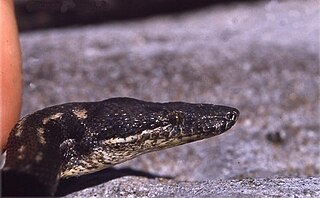
The Anomalepididae are a family of nonvenomous snakes, native to Central and South America. They are similar to Typhlopidae, except that some species possess a single tooth in the lower jaw. Currently, four genera and 15 species are recognized. Common names include primitive blind snake and dawn blind snake.

The Bolyeriidae are a family of snakes native to Mauritius and a few islands around it, especially Round Island. They also used to be found on the island of Mauritius, but were extirpated there due to human influence and foraging pigs in particular. These snakes used to be placed in the Boidae, but are now classed as a separate family. Two monotypic genera are recognized, but only a single species is extant. Bolyeriidae appear to be most closely related to the Asian genus Xenophidion.

Xenopeltis, the sunbeam snakes, are the sole genus of the monotypic family Xenopeltidae, the species of which are found in Southeast Asia. Sunbeam snakes are known for their highly iridescent scales. Three species are recognized, each one with no subspecies. Studies of DNA suggest that the xenopeltids are most closely related to the Mexican burrowing python and to the true pythons (Pythonidae).

Typhlops is a genus of blind snakes in the family Typhlopidae. The genus is endemic to the West Indies. Some species which were formerly placed in the genus Typhlops have been moved to the genera Afrotyphlops, Amerotyphlops, Anilios, Antillotyphlops, Argyrophis, Cubatyphlops, Indotyphlops, Letheobia, Madatyphlops, Malayotyphlops, and Xerotyphlops.
Ramphotyphlops is a genus of nonvenomous blind snakes of the family Typhlopidae. Member species of the genus are native to southern Asia and southeast Asia, as well as many islands in the southern Pacific Ocean. They occur in a wide variety of habitats. Currently, 22 species are recognized as being valid.

Rhinotyphlops is a genus of blind snakes in the family Typhlopidae. The genus is found in Africa, the Middle East, and India. Some species formerly assigned to the genus Rhinotyphlops have been moved to the genera Afrotyphlops and Letheobia.

Liotyphlops is a genus of blind snakes in the family Anomalepididae. The genus is native to Central America and South America. It contains 12 species that are recognized as being valid.
Helminthophis flavoterminatus is a species of snake in the Anomalepididae family. It is endemic to Colombia and Venezuela.
Liotyphlops anops is a species of snake in the family Anomalepididae. It is endemic to Colombia.
Liotyphlops argaleus is a species of snakes in the family Anomalepididae. It is endemic to Colombia.

Liotyphlops ternetzii beui is a species of nonvenomous snake in the family Anomalepididae. The species is native to northeastern Argentina, eastern Paraguay, and central-western, southeastern, and southern Brazil; the Reptile Database restricts its range to Brazil. It is locally common in Brazil. It is sometimes known as the pale-headed blindsnake.
Liotyphlops schubarti is a species of snake in the family Anomalepididae. The species is endemic to Brazil.

Liotyphlops wilderi, also known as Wilder's blind snake, is a species of snake in the family Anomalepididae. The species is endemic to Brazil.
The two-colored blind snake is a species of snake in the family Leptotyphlopidae. This species of snake are small, with a range usually between 15 and 20 cm in length.

Namibiana occidentalis, also known as the western threadsnake or western worm snake, is a species of snake in the family Leptotyphlopidae. It is found in Namibia and north-western South Africa.
The striped blind snake is a species of snake in the Typhlopidae family. Once claimed as being extinct, it was rediscovered in the Bukit Timah Nature Reserve in Singapore after 172 years. The snake was found dead, and it was 4 cm longer than the previous maximum limit of the snake's length, 48 cm.
The olive blind snake is a species of snake in the Typhlopidae family.
Sundatyphlops polygrammicus, also known as the Lesser Sunda blind snake or north-eastern blind snake is a species of snake in the Typhlopidae family.
The wedge-snouted blind snake, also known as the wedgenose blind snake, is a species of snake in the Typhlopidae family.








